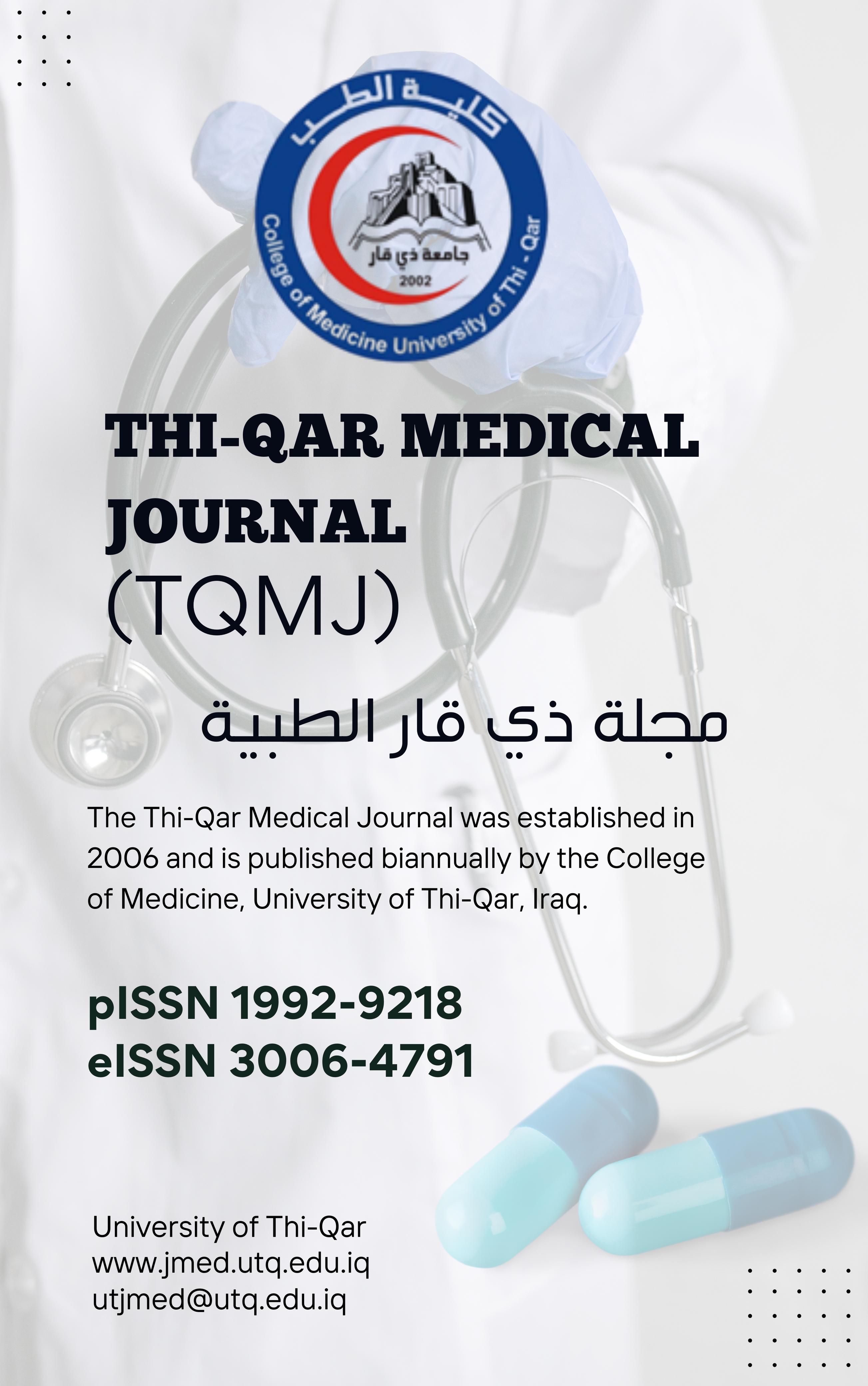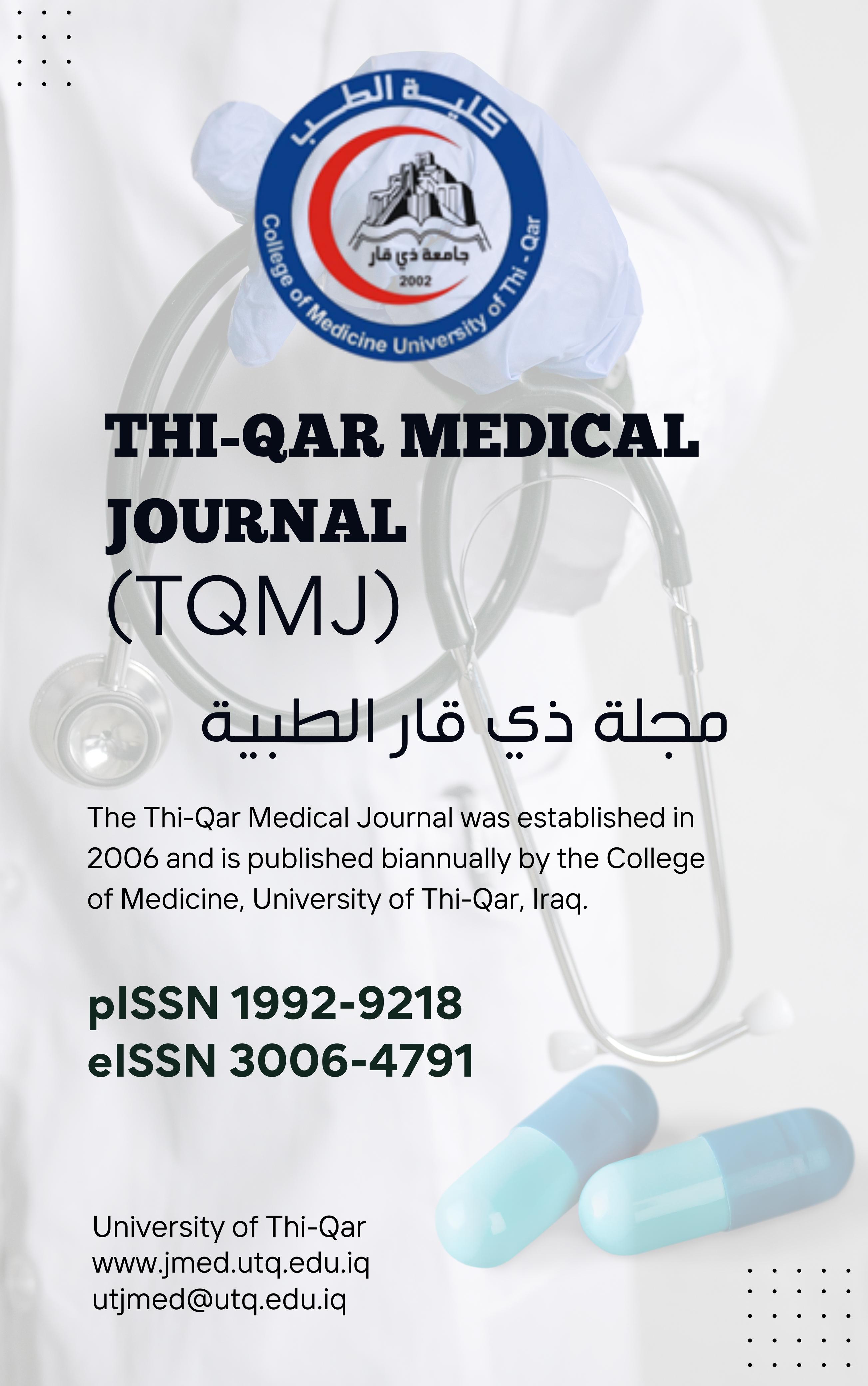Molecular Detection and Antibiotic Sensitivity of Acinetobacter baumannii isolated from Clinical Samples in Thi-Qar- Southern Iraq
DOI:
https://doi.org/10.32792/jmed.2025.29.8Keywords:
multiple antibiotic resistance, A. baumannii, resistance genes, ceftazidime, ciprofloxacin, and imipenemAbstract
Acinetobacter baumannii is a gram-negative coccobacillus and a critical globalhealth threat due to its high antibiotic resistance, particularly in hospital settings
and intensive care units (ICUs). As an ESKAPE pathogen, it causes severe
infections such as pneumonia, wound infections, and bloodstream infections,
especially in immunocompromised patients.This study aimed to characterize A.
baumannii clinical isolates in Southern Iraq, determine their antibiotic resistance
profiles, and identify key resistance genes. A total of 50 clinical isolates were
collected from Nasiriyah and Al-Hussein Hospitals, including sputum (28%),
burns (48.3%), and blood samples (24%). Identification and antimicrobial
susceptibility testing were performed using the VITEK-Compact system, while
molecular characterization was carried out using PCR to detect resistance genes.
Among the isolates, high resistance rates were observed in MDR strains,
particularly to ampicillin-sulbactam (95%), cefazoline (95%), piperacillin
(90%), doxycycline (90%), ceftazidime (80%), cefotaxime (80%), ciprofloxacin
(80%), levofloxacin (75%), ceftriaxone (75%), and imipenem (50%). Molecular
analysis confirmed the presence of resistance genes including blaOXA-51, BAP,
CsuE, and OmpA. The findings reveal an alarming prevalence of multidrug
resistant A. baumannii in clinical settings in Southern Iraq, highlighting the
urgent need for effective antimicrobial stewardship programs, strict infection
control measures, and the development of innovative therapeutic strategies to
combat these resistant pathogens.
References
Pour, N. K., Dusane, D. H., Dhakephalkar, P. K., Zamin, F. R., Zinjarde, S. S., & Chopade, B. A. (2011). Biofilm
formation by Acinetobacter baumannii strains isolated from urinary tract infection and urinary catheters. FEMS Immunology &
Medical Microbiology, 62(3), 328-338. https://doi.org/10.1111/j.1574-695X.2011.00818.x
Peleg, A. Y., Seifert, H., & Paterson, D. L. (2008). Acinetobacter baumannii: emergence of a successful pathogen. Clinical
microbiology reviews, 21(3), 538-582. https://doi.org/10.1128/cmr.00058-07
Blair, J. M., Webber, M. A., Baylay, A. J., Ogbolu, D. O., & Piddock, L. J. (2015). Molecular mechanisms of antibiotic
resistance. Nature reviews microbiology, 13(1), 42-51.doi:10.1038/nrmicro3380Published online 1 December 2014
Kyriakidis, I., Vasileiou, E., Pana, Z. D., & Tragiannidis, A. (2021). Acinetobacter baumannii antibiotic resistance
mechanisms. Pathogens, 10(3), 373. ; https://doi.org/10.3390/pathogens10030373
Akova, M. (2016). Epidemiology of antimicrobial resistance in bloodstream infections. Virulence, 7(3), 252-266.
https://doi.org/10.1080/21505594.2016.1159366
Joly-Guillou, M. L. (2005). Clinical impact and pathogenicity of Acinetobacter. Clinical microbiology and infection,
(11), 868-873. https://doi.org/10.1111/j.1469-0691.2005.01227.x
Rodriguez-Bano, J., Lopez-Cerero, L., Navarro, M. D., de Alba, P. D., & Pascual, A. (2008). Faecal carriage of extended
spectrum β-lactamase-producing Escherichia coli: prevalence, risk factors and molecular epidemiology. Journal of antimicrobial
chemotherapy,62(5),1142-1149. https://doi.org/10.1093/jac/dkn293
Jawad, A., Snelling, A. M., Heritage, J., & Hawkey, P. M. (1998). Comparison of ARDRA and rec A-RFLP analysis for
genomic species identification of Acinetobacter spp. FEMS microbiology letters, 165(2), 357-362. https://doi.org/10.1111/j.1574
1998.tb13170.x
Zidan, M. E., Samanje, J., & Nasir, H. M. (2022). Identification of Antibiotic Resistance of Acinetobacter baumannii in
Iraqi Patients. Journal of Techniques, 4(Special Issue), 28-32. : http://journal.mtu.edu.iq
clinical impact Kempf, M., & Rolain, J. M. (2012). Emergence of resistance to carbapenems in Acinetobacter baumannii in Europe:
and therapeutic options. International journal of antimicrobial agents, 39(2), 105-114.
https://doi.org/10.1016/j.ijantimicag.2011.10.004
quinolones, Prashanth, K., & Badrinath, S. (2004). In vitro susceptibility pattern of Acinetobacter species to commonly used
cephalosporins, and aminoglycosides. Indian journal of medical microbiology, 22(2), 97-103.
https://doi.org/10.1016/S0255-0857(21)02888-7
D'Arezzo, S., Principe, L., Capone, A., Petrosillo, N., Petrucca, A., & Visca, P. (2011). Changing carbapenemase gene
pattern in an epidemic multidrug-resistant Acinetobacter baumannii lineage causing multiple outbreaks in central Italy. Journal of
Antimicrobial Chemotherapy, 66(1), 54-61. https://doi.org/10.1093/jac/dkq407
Mustafa, M. S., & Abdullah, R. M. (2019). Detection of 16S rRNA Methylases and Co-Resistance with β-lactams among
Klebsiella pneumoniae Isolates from Iraqi Patients. Baghdad Sci J, 16(3), 580-587. : http://dx.doi.org/10.21123/bsj.2019.16.3.0580
Abd Al-Hassan, R. E., Hafidh, R. R., & Zaman, M. Z. (2023). Identification of klebsiella oxytoca by vitek-2 system in
baghdad hospitals. Journal of the Faculty of Medicine Baghdad, 65(4), 374-381. https://doi.org/10.32007/jfacmedbagdad.2154
Downloads
Published
Issue
Section
License
Copyright (c) 2025 Ruqayah Taher Habash, Dhuha Mahdi Jabir

This work is licensed under a Creative Commons Attribution 4.0 International License.





